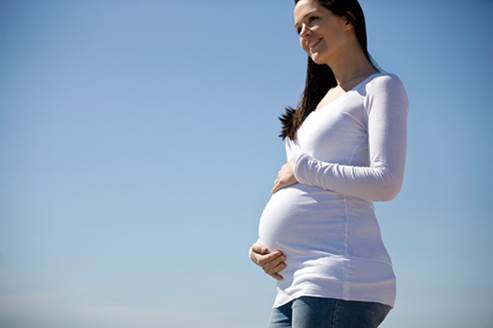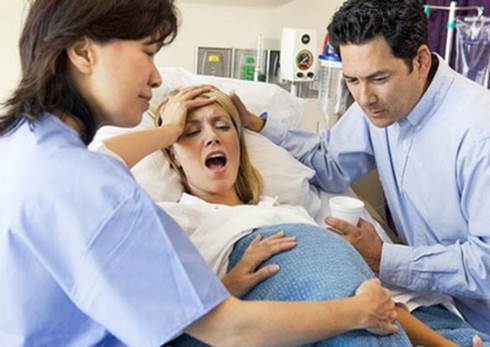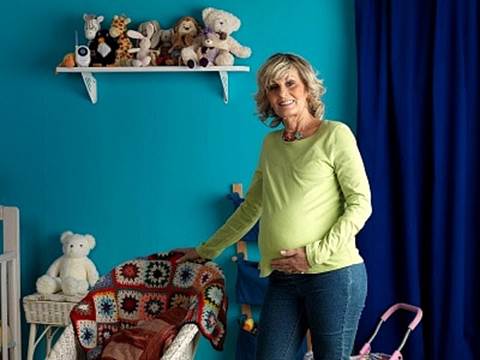In mother’s womb, babies can have
different postures.
Popular postures of babies in mother’s
womb: babies lie along, they will lie with horizontal direction, some babies
can lie with diagonal position. How does position affect the process of Birthgiving?
After the 30th week of
pregnancy, lying posture of babies in mother’s womb has special meaning. At
this time, babies grow up and they cannot move. It’s lucky when babies move to
classical posture, turning head below.

Popular
postures of babies in mothers’ womb: babies lie along, they will lie with
horizontal direction, some babies can lie with diagonal position.
Lying like that will make babies feel
comfortable before and after the time when they are born (because the biggest
parts of body are head and shoulder that are placed in blow part of uterus –
the largest place). In process of giving birth, head of fetus will be in
mother’s pelvis, nape will go through the whole surface of hipbone and then it
will turn back mother’s womb. Fetus will have stable position under public
symphysis and it will wait for labor to be born.
Unusual things
If babies turn their head below, giving
birth will become easily. However, this posture can also meet problem. For
example, in process of giving birth, babies can stretch their head: when head
goes through pelvis, baby’s head doesn’t get close to breast as normal, it turn
upward back.
In this case, baby’s brow or face will be
the first organ to move through bearing pipe and this thing can cause trauma for
both mother and baby. Phenomenon of brow or face moves first often takes place
to mothers giving birth in the next times. It can be the fact that baby is too
big or too small. In addition, maybe, mother’s hipbone is narrow, uterus is
deformed or mothers have fibroid uterus, have redundant amniotic fluid and
forward placenta.
When presentation isn’t propitious, mothers
can give birth naturally without intervening of surgery.
Brow presentation is defined in time of
giving birth when doctor test mother’s vagina. This is posture that cannot
adjust and pregnant women are often assigned to make surgery.
Face presentation is also defined with the
above way: doctor that carries out delivery will touch fetus’s eyes, nose and
mouth. To avoid complication, this case needs to be operated, but sometimes,
mothers can also adjust by themselves.
There are 3 types of upward-head posture
1.
Baby’s rump is in the below part of uterus, 2
legs stretch and along body (rump presentation lacks, rump type).
2.
Baby sits cross-legged, its legs fold and has
direct to below part of pelvis (rump presentation is enough).
3.
One or 2 legs are in below part of uterus (rump
presentation lacks, leg type).
If baby lies
across uterus, baby’s head and rump will be on 2 sides of mother.
There are many reasons that can lead to
opposite presentation: Mother has narrow pelvis, placenta isn’t in correct
position, uterus is deformed. Usual phenomena can also take place when fetus is
too small and it can move in uterus freely or short navel cord can prevent
fetus’s movement. Moreover, opposite presentation also takes place regularly in
the premature birth cases.
Define presentation
This thing can be done by testing outside
and palpating belly and then define result through testing vagina and
ultrasound scan.
Posture
of turning head below
You can know this thing on the 7th
month of pregnancy. If fetus is propitious, belly will have oval form. It
stretches to upper to lower, from the beginning part of rib to public
symphysis. In the upper part of uterus, doctor will see fetus’s rump (big and
soft), the lower part of uterus is head (round and hard), 2 sides are back,
hands and legs of baby.
Sitting
posture
You can diagnose this posture from the 32th
week of pregnancy. On the upper part of uterus, doctor can touch baby’s head
(hard), and the below part is rump (soft).
Position
of horizontal lying
You can define this posture from the 20th
week of pregnancy. Baby’s head and rump are on 2 sides of mother.
Sometimes, babies can be more compliant
when their mothers begin labor and they will turn their heads below. Doctors
can also help babies, for example, if babies lie with diagonal way, they will
let mothers lie on their side in a while so that babies can move posture of
lying along.
No problem with narrowness
What would take place if mothers give birth
to wins? When babies have incorrect lying posture because of narrowness, giving
birth will be decided due to particular cases. If one baby turns its rump below
and the other turns its rump upper, mother will be assigned to be operated.
If one baby turns its head below and the
other turns across, both of them can be born with natural childbirth. In
process of giving birth to the second baby, doctors have to turn to help it
have necessary posture.

To
giving birth to twins, doctors will have nomination for particular cases.
Evaluate from every aspect
Women that have opposite presentation, they
should go to obstetrics and gynecology about 2 weeks before giving birth. This
is time for doctors to test and define form of giving birth. For example, with
method of taking an X-ray of pelvis, experts can define that mother’s pelvis is
large enough to let the baby go through or not.
In addition, mother’s age is an important
element (over or under 30 years old) to size and weight of babies, head posture
of babies (bend down breast or turn upward back) and exact posture of babies in
womb.

Mothers’
age is an important element (over or under 30 years old) to size and weight of
babies, head posture of babies and exact posture of babies in womb.
If fetus is small, its head bends down
breast and pregnant women’s pelvis has normal size, doctors will agree with
natural childbirth. However, you always remember that process of giving birth
will become more complex if presentation is opposite.
For example, uterus will have difficult in
embracing fetus with horizontal posture, so labor will become weak and process
of giving birth will last. Sometimes, it will lead to situations that are more
complex, for example baby’s hands will be dropped. Therefore, in many cases,
making surgery is a safe decision for both mother and baby.